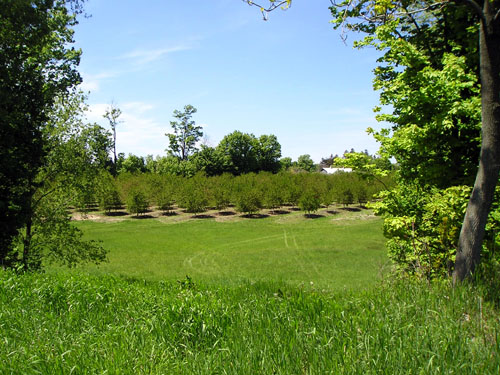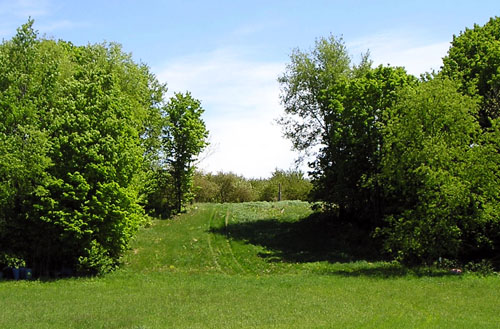Analyzing & Improving Farm Air Drainage
By Mark Longstroth, Michigan State University Extension
Spring frosts can cause significant losses to fruit crops. Classic radiation frosts with clear skies and calm conditions are common in all fruit growing regions. In a radiation frost, the ground cools by radiation to the sky. The cold ground cools the air above it. It is this cold air that causes frost or freeze damage. It is a good idea to routinely assess the air drainage on your farm. Plant growth and construction will cause air drainage to change over time and maintaining good air drainage can save a grower a crop in years when frost hits a region. There are numerous sites where a degree or two could be gained by removing obstructions from air drainage passages under radiation freeze conditions.

A fruit grower made this cut to promote air drainage into the field below.

This opening will allow a lot of cold air to leave the orchard and go someplace else.
Physics of air drainage
Air is subject to the laws of thermodynamics and hydraulics. Cold air is denser than warm air. Because of external energy and wind currents, the air can have different temperature layers vertically or horizontally. Cold air sinks, flowing downhill to the lowest available point where it accumulates until dispersed by heat or wind. Even on still nights there is air movement on slopes. Steeper slopes cause air to move faster. It takes energy to move air through or around obstructions. Therefore cold air often accumulates above obstacles. For air drainage under calm conditions, we are only concerned with low-level air currents from ground level to 100 feet or less.
Diagnosis
Mornings with low-lying ground fog (10 to 20 feet) are ideal for assessing air drainage. At dawn, go to highest spot on the farm and make note of where fog patches lie. Walk through these areas noting where fog is thickest and where it thins out. Look for obstructions that keep the fog in the area. Watch for moving fog banks – they show the natural airflow if there is no wind. Follow surface water drainage pattern, it will tell you where cold air travels.
Fruit sites should have large air storage areas within a half-mile or at least allow a general airflow to a storage area within one mile. Cold air storage over bodies of open water is larger than it appears. Heat and water vapor from open water warms the air in contact with it. This causes air to rise, making room for more air to enter.
Even on still nights, air movement down slope creates a slight breeze (1 to 3 miles per hour). One good way to find these breezes is with a helium balloon on a string. The balloon will tip in direction of airflow.
Treatment
There are basically three things you can do to help air drainage: Remove obstacles to air drainage, maintain drainage ways in good condition, and create more cold air storage off site. Solid obstructions block airflow, causing it to stop and pile up higher than the obstacle (often two to three times higher) before it pours over the obstacle. Colder dense air will pile higher than warmer air. Obstructions tight to the ground are more effective air dams than obstructions with openings near the ground. Sixty feet is the minimum width opening for good airflow. The larger the area being drained through the opening the wider the opening should be.
Places to clear of obstructions
- Any low waterways going off of farm to lower elevations.
- Tree lines or woodlots in or crossing air drainways.
- Bulldoze out humps or earth dams.
- Cut openings through side of enclosed basins to areas of lower elevations, or fill and grade surface toward lower elevation. Fill small potholes if they can’t be opened.
Thin out the cold air layer by increasing drainage
- Mowing air drains very closely in spring helps increase airflow by decreasing friction, so keep air drainage areas mowed and cleared.
- Make steeper slopes where practical to speed airflow to lower elevations.
- Open up restrictions as you can.
- Maintain openings at 60 feet or more.
Add energy to the air in form of heat or speed using fans, slopes or increased air storage
- Large (100,000 CFM) farms operating in air drainage ways can be useful in speeding airflow. Narrow areas benefit more than wide ones.
- Adding heat by burning creates a rising air column. This is most useful in areas that collect cold air. Heating the cold air causes it to rise, allowing more cold air to flow into the area. The larger the area (five acres minimum) heated, the more efficient this is.
Points to remember
Maintaining good air drainage is a never-ending task. Analyze every field for potential alternations before replanting. Plant appropriate varieties, such as late budding varieties, that can handle more cold since they are not as well developed on the date of a freeze. Remember that north and east facing slopes get cold slightly faster than south to west facing slopes. Place earlier growing fruits in warmer sites and later fruit in the cooler sites.
Constantly assess air drainage. Any time you have ground fog, pay attention to where it is. This usually happens in the fall during harvest as moisture is condensed out of the air. Be aware of air drainage problems off your farm that will affect you. Work with your neighbors to open up air drainage even if you have to cover all expenses. Lastly, don’t let the county or state fill a road cut across your air drainage area without compensation.
Related Michigan State University (MSU) Extension News article: Air moving fans for improved air drainage.



 Print
Print Email
Email